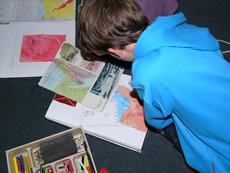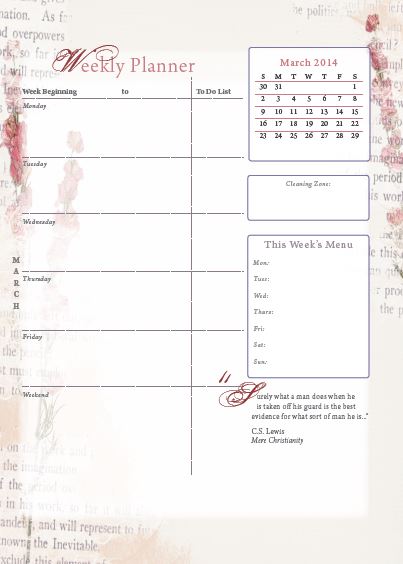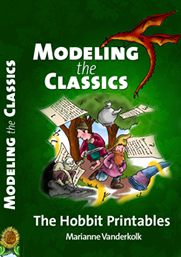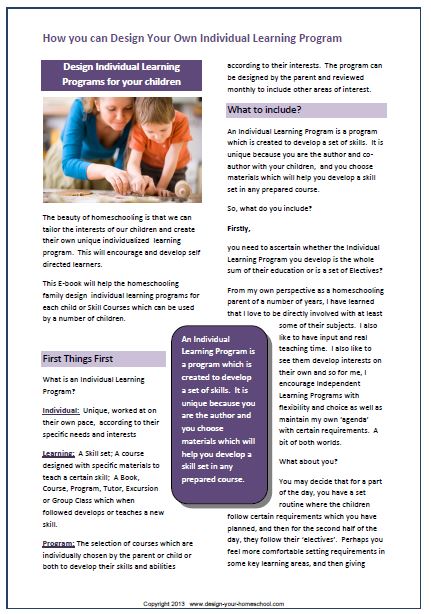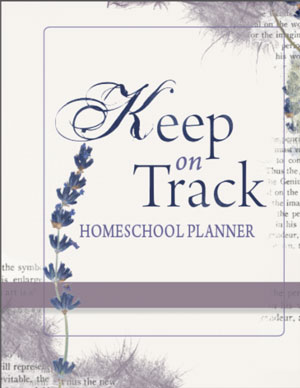Individualized Home Education - for unique children
Homeschooling: Trust Series
In this Series:
Article 1: Homeschool and Trust;
Article 2: Choosing Resources Wisely
Article 3: Individualized Home Education for Unique Individuals (this page)
Article 4: Your Support
You and your family are unique! God made you that way and the more we accept and work with that - the easier it will be to homeschool.
An individualized home education is the way you can discover your uniqueness as a family as far as your goals, direction, children, personalities and therefore learning styles and curriculum. The beauty of homeschooling is that you can style your child's education on exactly who they are and how they learn best.
Our children love to express their individuality just by being who they are.
Some love to cook; Others love to build, create, draw, read, paint, make music, fiddle with computers!
Over the lifetime of this website, I have added updates on our family and 5 years ago I wrote about how our children expressed their own individuality just by being who they are. Check out our homeschooling family in 2009.
So, as I said on that page, I love the fact that as we homeschool, our children have time to develop their own creativity and enjoy expressing their own personality and individuality in their own creative ways.
But what does Individuality have to do with TRUST? If we trust that God has uniquely created each individual child, with their gifts, talents and personalities, it would also mean that He has a specific plan for their lives. We can trust that God will prepare His children for their life of service, equip and develop them. We need to trust, pray, listen, watch and guide.
The Neglected Question: "What do you love to do?"
The most obvious, but sometimes neglected question to our children can be, "What do you love to do?"
If we want to guide our children to pursue their interests, we need to know what they love and the simplest way is to ask!
- If you had the whole day to do whatever you wanted... what would it be?
- What would you really love to learn about now?
- By the end of the year, what do you really want to improve on?
It is an important skill to be able to verbalize what you really love and create a plan to follow that desire. It takes time, thought, planning, a collection of appropriate resources to help our children pursue their own self directed, individualized home education.
This year, when I asked the question, "What do you think you need to know more about? What is important for you to learn?", I was surprised to hear "Math and Vocabulary" as a part of the answer! The rest of the answer also included, "crafts, cooking, nutrition, being a great writer" from my daughter, and "building Microsoft Apps" from one son and "making music" from another son! So different! But that's the beauty of being able to develop an individualized home education.
Expressions of Individuality
So, how do other children express their individuality? Each family is unique and on this page you can read from two other families and how their homeschools look different and how each child has been able to show their individualty as they pursue an individualized home education.
Ticia from Adventures in Mommydom
Our homeschool is very hands on. When my kids were in preschool that meant lots of arts and crafts, now that they are in elementary school that means we act out a lot of our assignments, and make it more real to them.
My boys are very interested in military history so we do lots of battle simulations to see why a certain side won the battle, and what advantage there is to that. My daughter enjoys acting out historical events, so we will often act out the lesson or play through it with our toys. We've also taken the time to visit places of interest. My husband and I are both very interested in history, so we spent a week in Colonial Williamsburg when we studied US history to get a better feel for the time period.
I love that homeschooling gives us the freedom to go on vacation in the middle of the school year and we can take our schoolwork with us. That's not a freedom most people have today.
We've also been able to go at my kids' natural pace. That means my daughter who is age-wise in 1st grade has completed all of 2nd grade reading and is roaring through 3rd grade as fast as she can. My sons who were slower in getting started reading have now "caught on," and they are trying their best to finish their 3rd grade reading before they finish 3rd grade and start on 4th grade.
We also had the freedom to look at a math curriculum we were using and decide it wasn't working for us and change curriculum in the middle of the school year because we weren't required to use that curriculum, so we changed to something else that worked. Homeschooling has been very freeing for all of us.
Ticia Adventures in Mommydom
How Beth Accommodates Her Children's Creativity
One night when my now-16-year old daughter was about 6, I was saying good night to her and asked if she had a good day. She replied with a deep sigh, "I guess so, but I didn't draw AT ALL today."
This is the girl who spent at least 2 hours drawing during quiet time while her younger siblings took a nap or did their own quiet time and another hour or so at night drawing before lights out. For whatever reason, we must not have been home for quiet time that day and the busyness led right up to a later-than-usual bed time. Even though it was late, I was so happy to let her leave the light on and draw until she got tired.
First of all, if she were in a conventional school, I would never have been able to let her stay up.
More importantly, it was in that moment that I realized that art was as much a part of her as breathing is to me. I also knew that a conventional school schedule would never allow the time (hours a day) for her to immerse herself in drawing, painting, later photography, videography and graphic design. Which, by the way, I'm convinced was so important for her brain development and growth.
Homeschooling has given us the flexibility to accommodate her innate need to truly create. Both she and my younger daughter are gifted artists and I cringe to think that this huge part of them would only be a blip on the radar screen had they gone to a conventional school.
She's had the time to turn her passion for art into a mini business creating custom portraits, blog designs, senior and family photos and even videos.
More Individualized Home Education Stories
Creating a Stimulating Learning Environment for an Individualized Home Education
Home education to me has always been my second education and what I have found over the years is that my enthusiasm is a great encouragement to my children.
Of course, the inverse is true too. When I have been preoccupied (and that does happen!) and I lose focus and just go through the motions of making sure my children have ticked their boxes, their joy is zapped too.
So, I have learned in my situation and in my family, that I need to be fully on board and excited about the process of learning in all sorts of areas.
What are some practical ways we can create a stimulating home environment to develop an individualized home education?
- Family Learning - the best part of our day is when we learn together. We read, discuss, draw maps, enjoy literature, draw, create art, make tables, memorize things, order timelines, play games. It's our "Circle Time" or "Morning Time" routine.
- Appreciate Individuality - As the title suggests, an individualized home education means that children are taken seriously as real individuals, with real interests, passions and as parents, we need to encourage, guide and mentor them. We need to be the coaches and cheerleaders!
- Work in a History Framework - We love to delve into a time period of history and that is the hinge that so much of our other work comes from (writing, literature, reading, geography, government, Bible)
- Exciting Homeschooling Resources - We have used Tapestry of Grace for years and the more I use it, the more I benefit from using it. My family can all read on their own now so they have their own reading and writing assignments as well as things which we do together. We are also enjoying Teaching Textbooks, Math U See, Life of Fred, Phonetic Zoo, Wordly Wise, Winston Grammar, Latin for Children, Rosetta Stone. These have worked well in our family.
- Read Aloud !! The best part of our homeschool day! When the children have completed their individual work, we sit together in the lounge. They gather around with pens, pencils, charcoal, drawing pads, history books, finger knitting, etc and I read aloud. I read literature, poetry, history - both non-fiction and historical fiction, Science. Look at other homeschooler's favourite read alouds. We also enjoy listening to audio books at this time. Thanks to librivox.org.
- Plan my week ahead of time - I write all the details for the next week into my homeschool planner. I use a Unit Study and Table format to enter my details.
- Add details into my children's homeschool planners - I add all their specific assignments into their planners so they can mark off what they have done.
- Keep a check on their workload - I hover around the children as they progress through their individual work in the morning assisting as needed.
- Check their planners at the end of the week - We add up all the completed assignments and make a score at the end of the week.
- Reward good efforts - Over the years we have had "Friday Shop" at the end of the week in which the children can trade their points for certain items such as muesli bars, lollies, pencils, pads, computer time, a video/dvd, drinks and so on.
- Focussed attention in the mornings - limit outside interruptions as much as possible. I am very careful not to make appointments in the morning and keep away from my own computer! :)
- Organize and Set up our Homeschool Learning Environment - I wrote more about bookshelves, special corners, and desks on this page. You can set up places where your children have time and resources to pursue their own interests;
- Be involved in a Support Group - We all need to connect somewhere with others who are on the same journey. Join my homeschooling e-zine and join me on the journey!
- Keep to a Routine - Although I have tried all sorts of routines, this is the one which we always revert back to.
- Breakfast and Chores
- Bible (personal), Bible (together)
- Memorization time (different things on different days - this is something which I will make available on my website in the months to come)
- Individual Study Time - music, Math, latin, spelling, vocabulary, computer programs, Dutch, Science Reading
- Read aloud Time - includes drawing, maps, discussion, literature, non-fiction and fiction reading.
- Lunch
- Book Box time - individual reading time from their Classics Book shelves; Time for older children to complete individual study time if needed.
- Free afternoon time - interests, playing, games, sports, clubs,
Individual Learning ProgramOne way to encourage self directed learning in your homeschool is to set up independent or individualized learning programs. These can also be called self directed learning contracts. Read more about self directed learning. |




